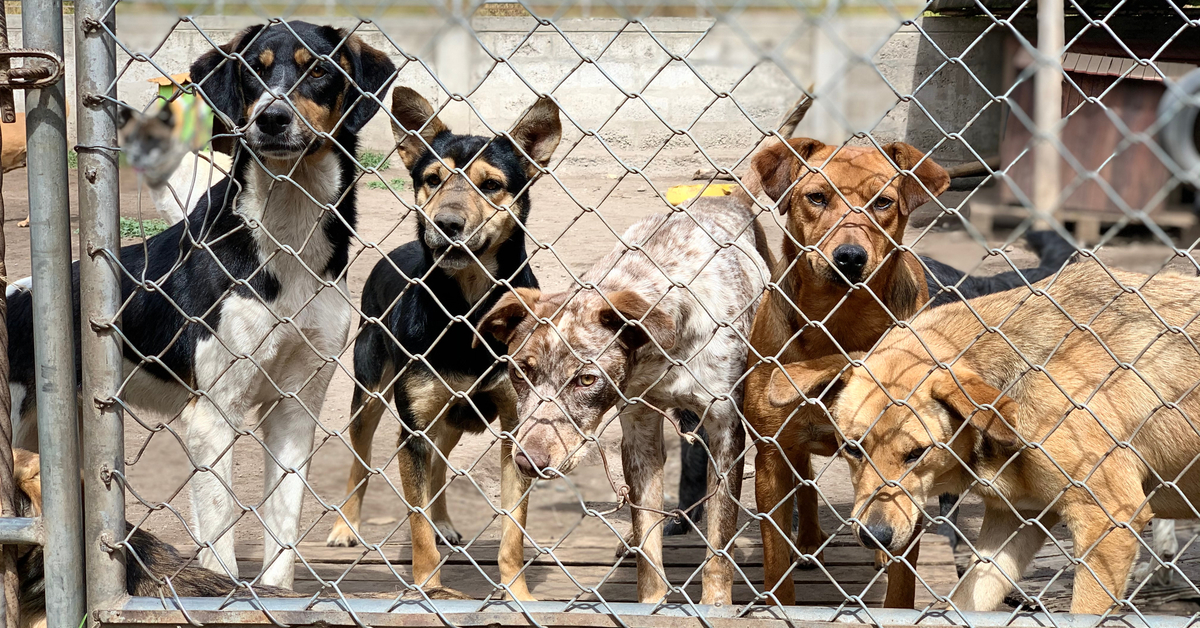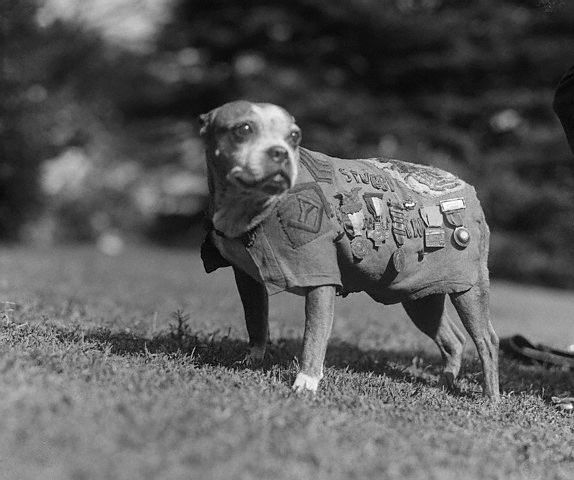One of the most iconic, popular, and yet misunderstood dogs in America is the pit bull terrier. As there are very strong opinions on both sides, this post serves to educate the public about pit bull statistics, evidence-based facts, and breed history.
These dogs were celebrated as war heroes, then decades later mislabeled by some as the most dangerous dogs in America. But what’s truth and what’s fiction about these dogs?
Understanding Pit Bull Facts & Pit Bull Statistics

Did you know that pit bull isn’t actually a breed? Most dogs labeled as “pit bulls” are mixed breed dogs.
We all think we know what a pit bull breed is, but do we? Recent studies show that the vast majority of pit bull-type dogs are mixed breeds containing less than 50% DNA of pit bull ancestry.
Dogs are labeled as “pit bulls” or “pit bull-type dogs” based on specific physical characteristics that include:
- A large, broad head
- Medium- to large size
- Short coat
- Muscular build
Breeds that are commonly identified as pit bulls include:
- American Staffordshire terrier
- American pit bull terrier
- Staffordshire bull terrier
- Boxers
- American bully
- American bulldogs
- Mastiffs
The American pit bull terrier is a breed recognized by the United Kennel Club (UKC) but not by the American Kennel Club (AKC).
Misidentification

Even though dog professionals like to think that we’re pretty good at identifying dog breeds, science shows otherwise. In a recent study conducted in a shelter environment, pit bull-type dogs were misidentified by dog professionals 60% of the time (based on the dogs’ actual DNA results).
This is problematic for many reasons.
The overwhelming cultural bias against pit bulls makes the difference between getting adopted by families or staying in a shelter longer.
The study concluded that matchmaking and adoption efforts at shelters should be based on behavior, not breed or perceived breed.
Instead of judging a book by its cover, we need to look at dogs as individuals.
Common Pit Bull Myths

Perhaps no type of dog is surrounded by as much misconception, misinformation, and mythology as the pit bull terrier. The myths around the breed center around the idea that they are somehow different than other breeds of dogs.
No scientific study has ever shown pit bull-type dogs to be more involved in bite incidents than any other breed of dog.
Other misbeliefs are that they are inherently aggressive dogs that attack unprovoked and that they have locking jaws. No scientifically validated study has linked aggression and breed. There is nothing unique about the jaw structure of these dogs that would cause their jaws to lock while biting.
Also worth noting is that pitbull-type dogs do not have the strongest bite of any breed of dog. Their bite and jaw are not special or different from any other dog.
Dogs are individuals

Prospective pit bull owners should be aware that this is an energetic breed that requires a lot of exercise and enrichment. Then again, some favor naps, lounging and cuddles to games of fetch.
Every dog is different. Like many other dog breeds including Chihuahuas or American Staffordshire terriers, they are not always as dog-social as, say, Labrador retrievers. This doesn’t mean they are bad dogs.
If you are looking to adopt any breed or mix-breed, temperament tests can give you information about what that individual dog’s temperament is like.
According to the American Temperament Test Society’s website, the temperament test “focuses on and measures different aspects of temperament such as stability, shyness, aggressiveness, and friendliness as well as the dog’s instinct for protectiveness towards its handler and/or self-preservation in the face of a threat.”
Pit bull-type dogs consistently perform better on temperament tests than popular ‘family’ dogs like labs, border collies, and golden retrievers.
A Complicated History

The pit bull has a complicated and interesting history.
A number of dog-owning British immigrants coming to America brought their pit bull-type dogs with them. Although some were first bred as fighting dogs, they were also invaluable to their families.
Despite the inhumane way their ancestors were treated being forced to partake in dogfighting, pit bulls became popular all-around farm and family dogs. Thomas Edison, Theodore Roosevelt, and Helen Keller are amongst the famous people in history to have shared their homes with pit bull-type dogs.
These dogs also became American mascots during the first and second world wars as the poster pups of patriotism. One of the most notorious of these dogs was Sergeant Stubby.
Sgt. Stubby became the most decorated canine war hero in WWI after he located wounded soldiers, and alerted troops to the location of enemy soldiers.
After the first and second world wars, pitbull-type dogs continued to be popular in advertisements as well as in television shows like “Little Rascals.”
Pitbull Statistics and Breed Specific Legislation

Despite their popularity as the all-American family dog after WWII, the reputation of pit bulls shifted dramatically with the uptick of selective media coverage. This, despite dog bite statistics that show pit bull-type dogs are no more likely to be aggressive than any other breed.
A 2008 study conducted by researchers at the University of Veterinary Medicine of Hanover Germany showed no difference in aggression between pit bull-type dogs routinely targeted by BSL, and dogs in the control group comprised of golden retrievers.
Regardless, pit bull-type dogs have continued to be unfairly targeted by communities and politicians.
Breaking down BSL
Breed-specific legislation (BSL) is laws or regulations that specifically target certain breeds of dogs. On the smallest scale, BSL might look like:
- An apartment building refusing to rent to people who own certain breeds of dogs;
- A home insurance policy refusing to cover certain dog breeds;
- Home insurance companies that charge more if homeowners have a specific dog breed.
On larger levels BSL means:
- Cities, counties, states, or other municipalities that ban or limit the ownership of certain breeds;
- Prevents these dogs from traveling through or visiting an area with BSL;
- Owners are fined for having dogs not permitted to live in the area;
- In crueler instances, these dogs can be seized and euthanized.
Pit bulls and pit bull mixes are not the only types of dogs targeted by BSL. Other common breeds include Dobermans, German shepherds, and rottweilers under the assumption that they are more prone to aggressive behavior than other breeds. Pit bulls, however, are often a primary target of these laws.
BSL just doesn’t work

Currently, over 700 localities within the United States have some form of breed-specific legislation on the books. However, thanks to the work of advocates and researchers, more communities are reversing outdated and discriminatory BSL policies.
Currently, there are 22 states that prohibit any legislation that discriminates against a dog based on breed.
Breed-specific legislation is an outdated and unscientific approach theoretically designed to protect communities from dog bites and fatal dog attacks. BSL is consistently shown to be an ineffective way of increasing public safety.
BSL also costs a lot of money for you — the taxpayer. In Denver alone, BSL has cost taxpayers over $100,000,000 with no impact on public safety.
And in just a two-year period, Prince Georges County, Maryland spends $560,000.
National recognition of BSL’s ineffectiveness
Major companies, U.S. bodies of government, and organizations that oppose BSL include:
- Centers for Disease Control and Prevention (CDC)
- The U.S. Department of Justice
- The U.S. Department of Housing and Urban Development
- American Bar Association
- American Veterinary Medical Association (AVMA)
- National Canine Research Council
- American Kennel Club
- State Farm Insurance
The American Veterinary Medical Association has been a vocal opponent of BSL, noting that all dogs, regardless of breed and size, are capable of dog attacks and causing serious injury and even dog bite-related fatalities.
Similarly, the American Bar Association supports breed-neutral legislation. These are rules that encourage responsible dog ownership but don’t target any specific breed of dog.
The Humane Society of the United States maintains a comprehensive list of leading national organizations that oppose discrimination based on the breed of dog for those interested in reading more.
Social Justice

As America grapples with understanding the ways white supremacy is enshrined within our policing and legal systems, it’s important to understand the way pit bull-type dogs are unfairly targeted.
Not only is breed-specific legislation not based on fact or science, but it is also disproportionately applied to the dog population in poor communities and to dog owners of color.
A study by the University of Denver containing pit bull statistics revealed that there was unequal enforcement of the pit bull ban where “racially diverse communities intersect with predominantly white neighborhoods.”
It is impossible to understand the way pit bulls have unfairly been targeted by animal control and police without also naming the ways that racism and classism contribute to the way animal welfare is understood across the country.
A new book by author and researcher Harlan Weaver, “Bad Dog: Pit Bull Politics and Multispecies Justice,” is an excellent read for those interested in learning and thinking more critically about intersectional oppression and how discrimination against pit bulls is linked to systemic racism in America.
In essence, Weaver uses pit bull statistics and ethnographic research to explore “how relationships between humans and animals not only reflect but actively shape experiences of race, gender, ethnicity, sexuality, nation, breed, and species.”
Keep an Open Mind

Though pit bulls are not the right family pet for everyone, they are wonderful dogs significantly wronged and misunderstood under the false idea of keeping communities safe. Just like any other large and high-energy type of dog, they require training and socialization.
And just like any other dog breed under the wrong circumstances, pit bull-type dogs can injure a person or another animal. However, pit bulls are consistently shown in research studies to not be any more likely to be involved in causing dog bite injuries than any other breed of dog.
The spread of misinformation about the breed stems from unscientific special interest groups and organizations (i.e., dogsbite.org). Since 60% of dogs identified as “pit bulls” do not have a single DNA signature of pitbull-type breeds, the information these biased groups provide about “pit bull attacks” or “pit bull bites” is moot.
Thankfully, the reputation of the breed has begun to shift in recent years in response to the tireless work of pit bull guardians and advocates.
Despite all the myths to the contrary, pit bull statistics and scientific studies show that they are not inherently blood-thirsty, dangerous dogs out mauling people and other people’s family pets.
Pit bull-type dogs are strong and intelligent dogs who excel at being loving family members, enjoying sports like dog agility and fetch and even work as service dogs, police dogs, and therapy dogs. They deserve a fair chance.
Further reading
For further evidence-based arguments for bully breeds, the nonprofit research group, Pitbullinfo.org, has a list of scientific peer-reviewed studies available to the public.
If you are interested in learning more about the fascinating history of these dogs, Bronwen Dickey’s book “Pit Bull: The Battle over an American Icon” is a comprehensive in-depth look into the history of the breed.
The nationally known San Franciso-based rescue group Bad Rap is also a great resource on the history of these dogs.
Sources
Stefanie A. Ott, Esther Schalke, Amelie M. von Gaertner, Hansjoachim Hackbarth,
Is there a difference? Comparison of golden retrievers and dogs affected by breed-specific legislation regarding aggressive behavior, Journal of Veterinary Behavior
Patronek GJ, Sacks JJ, Delise KM, Cleary DV, Marder AR. Co-occurrence of potentially preventable factors in 256 dog bite-related fatalities in the United States (2000-2009). J Am Vet Med Assoc. 2013 Dec 15;243(12):1726-36. doi: 10.2460/javma.243.12.1726. PMID: 24299544.
Gunter, Lisa M et al. “A canine identity crisis: Genetic breed heritage testing of shelter dogs.” PloS one vol. 13,8 e0202633. 23 Aug. 2018, doi:10.1371/journal.pone.0202633
Animal Law Review, University of Denver Institute for Human-Animal Connection (IHAC) at the Graduate School of Social Work (GSSW)
The Humane Society of the United States
American Temperament Test Society
Best Friends Animal Society
Badrap.org
Pitbullinfo.org
ASPCA
Pit Bull: The Battle over an American Icon by Bronwen Dickey
Bad Dog: Pit Bull Politics and Multispecies Justice by Harlan Weaver

